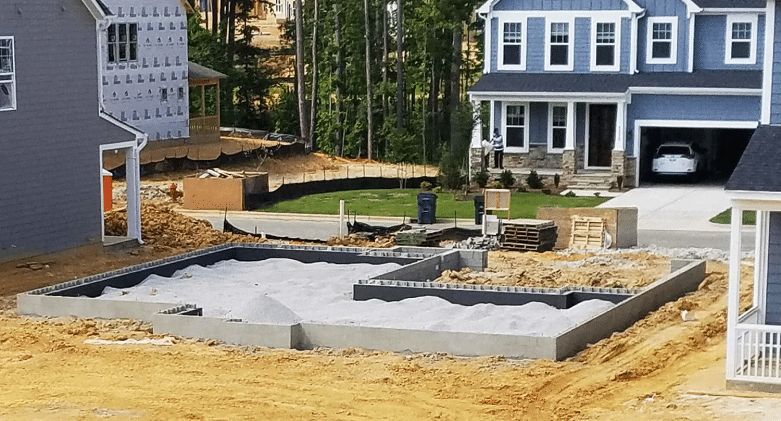The Benefits of a Stem Wall Foundation: Strength, Durability, and Stability for Your Home

When constructing a new home or building, choosing the right foundation is crucial for ensuring the structure’s long-term stability and durability. One highly recommended option is the stem wall foundation. This type of foundation offers numerous benefits, making it a popular choice in areas with varied soil conditions, flood zones, and homes requiring additional structural support.
In this article, we will explore the benefits of a stem wall foundation, how it works, and why it could be the ideal solution for your construction project.
What is a Stem Wall Foundation?
A stem wall foundation is a type of construction method where a wall is built on top of a concrete footing and then rises above ground level. This wall supports the structure’s weight and serves as a base for the exterior walls of the house or building. Stem walls are typically used in conjunction with slab foundations or crawl spaces, creating a durable, raised platform that protects the structure from environmental hazards and uneven soil conditions.
Key Benefits of Stem Wall Foundations
Choosing a stem wall foundation offers several advantages in terms of strength, stability, and adaptability. Below are the key benefits that make stem wall foundations a reliable choice:
Enhanced Structural Support
The main benefit of a stem wall foundation is its ability to provide enhanced structural support. The concrete footing and reinforced stem wall work together to distribute the building’s weight evenly, reducing the risk of shifting or settling over time. This ensures long-term stability, especially in areas with poor soil conditions or heavy loads.
Protection Against Flooding
In regions prone to heavy rainfall or flooding, stem walls offer crucial protection. The raised platform created by the stem wall helps keep the structure above floodwaters, minimizing water damage and ensuring the longevity of the foundation. This is particularly beneficial for homes built in flood-prone or coastal areas.
Resistance to Soil Movement
Soil expansion and contraction can pose significant risks to traditional foundations. However, stem wall foundations are designed to accommodate soil movement by allowing flexibility between the concrete footing and the wall itself. This minimizes the potential for cracking, shifting, or other damage caused by changing soil conditions, making it ideal for areas with expansive clay soils or seismic activity.
Improved Ventilation
Stem wall foundations with crawl spaces provide better airflow and ventilation underneath the building. This is particularly useful in areas with high humidity, as the increased ventilation helps reduce moisture buildup, mold growth, and wood rot, ultimately improving the air quality within the home.
Customizable Design for Varied Terrain
A stem wall foundation is highly adaptable and can be customized to suit various types of terrain. Whether you’re building on sloped land, uneven ground, or areas with poor soil quality, stem walls can be tailored to accommodate the specific challenges of your building site. This versatility is one of the reasons why stem wall foundations are preferred in many residential and commercial projects.
Insulation and Energy Efficiency
Stem walls create a natural buffer between the ground and the living space, helping to regulate temperature and increase energy efficiency. The raised foundation allows for the installation of insulation beneath the home, reducing heat loss and improving energy performance. This can lead to lower utility bills and a more comfortable living environment.
Stem Wall Foundation vs. Slab-on-Grade Foundation
To better understand the advantages of a stem wall foundation, it’s helpful to compare it with a slab-on-grade foundation, another common construction method.
| Feature | Stem Wall Foundation | Slab-on-Grade Foundation |
|---|---|---|
| Structural Support | Superior support for heavy loads | Limited to lighter structures |
| Flood Protection | Raised platform protects against floods | Vulnerable to water damage |
| Soil Movement Resistance | Flexible to accommodate soil changes | Prone to cracking in expansive soils |
| Terrain Adaptability | Can be customized for sloped/uneven land | Best for flat, stable ground |
| Ventilation | Allows for crawl space ventilation | No crawl space; limited airflow |
| Energy Efficiency | Insulation options increase efficiency | Less insulation, less energy-efficient |
As you can see, stem wall foundations offer distinct advantages over slab-on-grade foundations, particularly in areas with challenging terrain, variable soil conditions, or flood risks.
How Does a Stem Wall Foundation Work?
The construction of a stem wall foundation typically follows these steps:
Site Preparation: The ground is excavated, and the soil is compacted to create a stable base for the foundation.
Footing Installation: Concrete footings are poured below ground level to provide a stable platform for the stem wall. These footings are reinforced with steel rebar for additional strength.
Stem Wall Construction: A reinforced concrete stem wall is built on top of the footings, rising above ground level. This wall supports the weight of the building and creates a raised platform for the structure.
Foundation Slab or Crawl Space: Depending on the design, either a concrete slab is poured within the stem wall or a crawl space is created, allowing for ventilation and access to utilities.
Finishing Touches: Insulation, waterproofing, and drainage systems are installed to further protect the foundation and enhance energy efficiency.
FAQs about Stem Wall Foundations
What types of buildings benefit most from stem wall foundations?
Stem wall foundations are ideal for residential homes, particularly those in areas with uneven terrain, flood risks, or challenging soil conditions. They are also commonly used in commercial buildings that require added structural support.
How does a stem wall foundation protect against soil movement?
Stem wall foundations are designed to accommodate soil movement by separating the footing from the wall. This allows the foundation to remain stable, even when the soil expands or contracts due to moisture changes or seismic activity.
Is a stem wall foundation more expensive than other foundation types?
While a stem wall can be more expensive to install than a basic slab-on-grade foundation, the added benefits of stability, flood protection, and adaptability often justify the additional cost, particularly in regions where these factors are critical.
Can a stem wall foundation be used in earthquake-prone areas?
Yes, stem wall foundations are well-suited for earthquake-prone regions. Their flexibility and ability to absorb soil movement help reduce the risk of damage during seismic activity.
How long does a stem wall foundation last?
When properly constructed and maintained, a stem wall can last for several decades. Regular inspections, maintenance of drainage systems, and addressing any cracks or signs of damage promptly will help ensure the foundation’s longevity.
Choosing the Right Foundation for Your Home
Ultimately, the choice of foundation depends on several factors, including the location of the building site, soil conditions, and the type of structure being built. A stem wall is a reliable choice for anyone seeking enhanced structural support, protection from environmental hazards, and a durable foundation that will stand the test of time.
By considering the benefits of a stem wall, you can make an informed decision that ensures the long-term success of your construction project. Whether you’re building in a flood zone, on uneven terrain, or simply looking for added insulation and energy efficiency, this type of foundation offers the versatility and strength you need.





